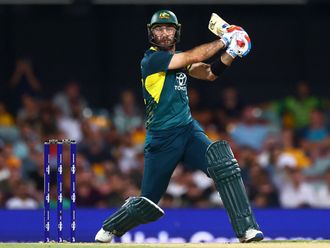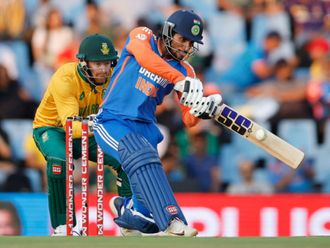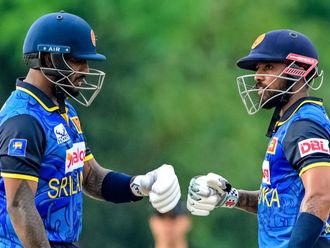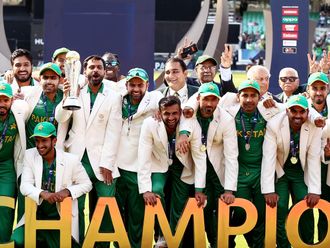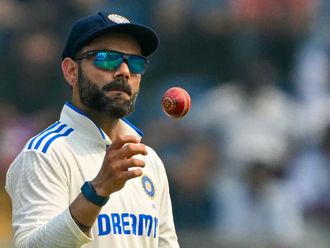
New Delhi: Sri Lanka batsman Angelo Mathews became the first player to be given "timed out" in the history of international cricket on Monday in a World Cup clash against Bangladesh.
The controversy overshadowed Charith Asalanka's fine 108 as Sri Lanka made 279 in a game they need to win to maintain their slim hopes of squeezing into the semi-finals.
Mathews had come into bat after the fall of Sadeera Samarawickrama in the 25th over but was unable to secure his helmet strap tightly enough, an action which delayed the resumption of play.
Bemused by decision
As a result, the former captain had taken more than two minutes to take strike and Bangladesh skipper Shakib Al Hasan appealed.
On-field umpires Marais Erasmus and Richard Illingworth talked to both teams before the decision was upheld.
The 36-year-old Mathews reluctantly trudged off with most spectators appearing bemused by the decision. Some Bangladesh fans applauded.
Not good for spirit of cricket
"Mathews' dismissal was not good for the spirit of cricket," said century-maker Asalanka.
Former South African fast bowler Dale Steyn writing on X, formerly Twitter, said: "Well, that wasn't cool".
According to laws of cricket, after the fall of a wicket or the retirement of a batsman, the incoming player must be ready to receive the ball within two minutes.
The Association of Cricket Statisticians and Historians said there have been six instances of "timed out" in first-class cricket.
First instance
"There have been no instances recorded in List A or Twenty20 cricket until Mathews," they wrote on X, formerly known as Twitter.
The vastly experienced Mathews was playing in his 225th One-Day International on Monday in a career, which has yielded 5,900 runs and 122 wickets.
He has also played 106 Tests and 78 Twenty20 internationals.
The match had been given the green light despite smog-choked New Delhi being ranked as the planet's most polluted major city.
A look at five other unusual cricket dismissals:
1947: Birth of the ‘Mankad’
During India’s tour of Australia, Vinoo Mankad had warned Australian opener Bill Brown against backing up too far at the non-striker’s end during a warm-up game at the Sydney Cricket Ground. When that advice was ignored, Mankad ran him out.
A month later, in the first Test at the same ground, Mankad again ran out Brown, this time with no warning, sparking a debate about the fairness of such dismissals that continues to this day and has led to them being labelled ‘Mankads’.
1979: Hilditch’s handling error
Australia batsman Andrew Hilditch became the first non-striker to be given out ‘handled the ball’ during a Test against Pakistan.
Hilditch picked up a wayward throw that had gone onto the pitch and handed the ball back to Sarfraz Nawaz.
The Pakistan paceman appealed and the umpire, under the Laws of Cricket, had to give Hilditch out.
There were suggestions Sarfraz’s act had been in retaliation for Pakistan No 11 Sikander Bakht being run out at the bowler’s end while backing up too far.
Pakistan all-rounder Asif Iqbal, who played in the match, said: “There was no need for us to stoop so low as to appeal against Hilditch for handling the ball as a non-striker.”
2002: Drakes’ ‘flying’ exit
‘Timed out’ only entered cricket’s law book in 1980 and has remained a relatively rare form of dismissal ever since.
One particularly unusual case took place during a South African domestic match in 2002.
Fast bowler Vasbert Drakes was selected to play for Border against Free State in East London. He had been playing for West Indies in the Champions Trophy in Sri Lanka but thought he could arrive in South Africa in time, only for his flight from Colombo to be delayed severely. Drakes missed out on batting but did take a couple of wickets on the second day.
2003: Harris’ groin strain pain
Seam bowler AJ Harris strained a groin muscle playing for Nottinghamshire against Durham University at Trent Bridge and didn’t expect to bat.
But the situation changed as Chris Read closed in on a hundred. Harris — and his runner — started to get changed when the No 10 batsman went on. But the tailender was out third ball and by the time Harris had hobbled down the pavilion steps, he met the umpires and players coming the other way, with Read, stranded on 94 not out.
Harris had exceeded the then stipulated three minutes for his arrival at the crease.
“No one appealed,” he recalled, “but I was given out nonetheless.”
2023: Bairstow exit sparks Lord’s flare-up
Lord’s erupted in fury following the controversial exit of England batsman Jonny Bairstow during the last day of this year’s second Ashes Test.
Spectators were incensed following an incident where Australia wicketkeeper Alex Carey threw the ball at the stumps after Bairstow walked out of his crease, thinking the ball was dead.
The umpires had no choice but to confirm the dismissal.
But that was not the end of the matter.
The tourists were confronted in the pavilion at Lord’s, the headquarters of the MCC, as they returned to their dressing room for lunch.
A flashpoint between Australian batsmen Usman Khawaja and David Warner and MCC members was caught by television cameras.
MCC subsequently expelled one member following the ugly altercation.
— AFP
Rebuilding the innings
On the pitch, left-handed Asalanka stood firm to rebuild the Sri Lanka innings after they had slipped to 135-5 following the exit of Mathews.
Asalanka put on key stands including 78 runs with Dhananjaya de Silva, who made 34, as he reached his second ODI ton in 101 balls amid applause from a crowd of over 15,000.
After hitting six boundaries and five sixes, he finally fell to Tanzim Hasan Sakib, who finished with figures of 3-80.
The Sri Lankan innings ended in 49.3 overs.
Bangladesh are out of the race for the semi-finals while Sri Lanka only have a mathematical chance of making the final-four.
The two teams are fighting to qualify for the 2025 Champions Trophy.


